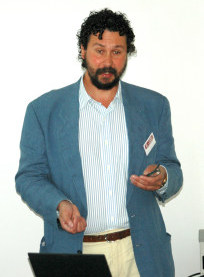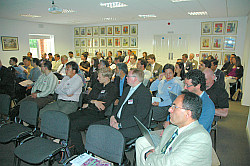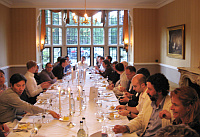Fifth International Conference on Computational and Experimental Methods in Multiphase and Complex Flow
New Forest, UK
Overview
 The 5th International Conference on Computational Methods in Multiphase Flow took place recently at the Wessex Institute of Technology Campus in the New Forest, organised by the Institute, represented by its Director, Professor Carlos Brebbia and by the University of New Mexico, represented by the Co-Chair, Professor Andrea Mammoli.
The 5th International Conference on Computational Methods in Multiphase Flow took place recently at the Wessex Institute of Technology Campus in the New Forest, organised by the Institute, represented by its Director, Professor Carlos Brebbia and by the University of New Mexico, represented by the Co-Chair, Professor Andrea Mammoli.The first conference in the series was held at the University of Florida in Orlando (2001), followed by one in Santa Fe, New Mexico (2003); another in Portland, Maine (2005) and the last one in Bologna, Italy (2007).
Professionals in the energy, automotive manufacturing, construction, food processing and pharmaceutical industries, to name a few, are frequently faced with problems associated with multiphase flow. Scientists in environmental sciences, biology and medicine also encounter multiphase flows regularly. Despite the efforts of several generations of fluid mechanists who tackled multiphase flows, including Einstein in the early 20th Century, a complete description of this behaviour still eludes us. Constructive equations have been developed for some cases and numerical models based on these have been successful at predicting phenomena such as particle migration in dense suspensions. Much of the inspiration for the development of models comes from experimental observation. In some cases, the phenomena of interest are recorded directly, while in other cases, simplified models of the flows are necessary to restrict and control the parameter space. Direct numerical simulation is becoming increasingly useful for providing insight into constitutive models and in some cases even for calibrating models. However it remains true that very specialised models are developed for individual cases.
Opening Address
 Andrea Mammoli welcomed the delegates to the meeting, saying that the organisers hoped the conference participants would benefit from many fruitful exchanges of ideas. The readers of the conference book will find many insights into new developments in multiphase flow. The book contents reflect the quality of the submissions and the diligence of the reviewers.
Andrea Mammoli welcomed the delegates to the meeting, saying that the organisers hoped the conference participants would benefit from many fruitful exchanges of ideas. The readers of the conference book will find many insights into new developments in multiphase flow. The book contents reflect the quality of the submissions and the diligence of the reviewers.Professor Brebbia explained the objectives of the Wessex Institute and in particular its commitment to act as a mechanism for the transfer of knowledge between academic, industrial users and society in general. The conference programme is an important part of the activities, as well as the publishing work. WIT Press, the publishing arm of the Institute, produces around 50 books per year, half of them conference proceedings. They are published in hard cover format as well as digitally; the latter being a new initiative and promoted through a worldwide network of eBook distributors. Professor Brebbia explained that the demand for digital material will continue to grow, particularly in the scientific and technical fields, and that it is important to ensure that we are able to respond to it to ensure the largest possible distribution of the papers presented at conferences such as Multiphase Flow.
Conference Sessions
The papers presented at the conference described several examples of modelling approaches, each well suited to a particular application, presenting a view of the breadth of the field. Another part of the conference comprised papers describing experimental observations of multiphase flows at a wide range of scales. Topics include turbulence, interfaces, and fluid dynamics effects. Experimental techniques such as PIV and other imaging methods were also represented.
The papers were grouped in the following sessions:
- Multiphase flow simulation
- Interaction of gas, liquids and solids
- Turbulent flow
- Environmental multiphase flow
- Bubble and drop dynamics
- Flow in porous media
- Image processing
- Interfacial behaviour
Keynote Addresses
The conference also included a series of keynote addresses:- “3D Eulerian simulation of a gas-solid bubbling fluidized bed: assessment of drag coefficient correlations” by N Mahinpey, University of Calgary, Canada
- “LBM simulation of interfacial behaviour of bubbles flow at low Reynolds number in a square microchannel” by Y.Y. Yan, University of Nottingham, UK.
- “Modelling the tide effects in groundwater”, J. Mls, Charles University, Czech Republic
- “Mathematical modelling on particle diffusion in fluidised beds and dense turbulent two-phase flows” by R. Groll, Centre of Applied Space Technology, Germany
Excursion
The delegates had numerous occasions to meet outside the conference sessions. A special lunch-time excursion was organised during the first day of the meeting to a local Museum and place of interest on the Beaulieu River, called Buckler’s Hard. Ships were built in Buckler’s Hard nearly for 100 years and launched directly into the river. Henry Adams, a famous master builder, was appointed in 1749 by the local Lord of the Manor, to create a shipyard. At its height, there were five shipways and around twenty cottages for the workers. Only two rows of the cottages now remain; at the end of one of them stands a hotel which was the master builder’s house. An excellent display at the entrance to the village describes the activities that took place.
Many fine ships were built there, including the famous Agamemnon, commanded by Nelson during the siege of Calvi, in which he lost the vision of his right eye. This ship, together with Swiftsure and Euryalus, all built at Buckler’s Hard, took part in the Battle of Trafalgar. In 1818, the construction of ships ceased, mainly as a consequence of the enterprise having over-extended itself. Adams had been contracted to build ships simultaneously but was unable to deliver them on time to the Navy and the resulting fines and litigation destroyed the business.
International Scientific Advisory Committee
The members of the Scientific Advisory Committee met over dinner with the Conference Co-Chairmen to discuss the progress of the meeting and to see which new topics could be included in the 2011 Call for Papers. Several new members of the Committee were nominated and the location of the next conference discussed in detail.
Conference Dinner
The conference dinner took place in a well known New Forest hotel called Rhinefield House. This was originally one of the lodges of the Master Keeper and later became the residence of the Forest Nurseryman, who created an ornamental drive and planted many trees in the grounds. At the end of the 19th century this lodge was sold to the Walker family, whose only daughter married a Royal Navy Officer called Munro in 1887 and the couple adopted the name Walker-Munro. They then demolished the original lodge and started building an impressive new house. The most impressive room in the house is the great hall with a hammer-beam roof resembling that in Westminster Hall in the Houses of Parliament. In keeping with the variety of styles in the house, the dining room is beautifully panelled with a large carving on the mantelpiece representing the defeat of the Spanish Armada. Other smaller rooms are decorated in Italian and French styles, the most surprising being the Alhambra room. This is a smoking room, inspired by the Alhambra Palace. The walls have the type of gesso work associated with Mudejar architecture. Below this the walls are covered in beautiful Moorish tiles. A mosaic floor and six columns add to the lightness of the room.
The most impressive room in the house is the great hall with a hammer-beam roof resembling that in Westminster Hall in the Houses of Parliament. In keeping with the variety of styles in the house, the dining room is beautifully panelled with a large carving on the mantelpiece representing the defeat of the Spanish Armada. Other smaller rooms are decorated in Italian and French styles, the most surprising being the Alhambra room. This is a smoking room, inspired by the Alhambra Palace. The walls have the type of gesso work associated with Mudejar architecture. Below this the walls are covered in beautiful Moorish tiles. A mosaic floor and six columns add to the lightness of the room.The conference dinner took place in the Keepers Room, another of the remarkable rooms in this unique Forest lodging. There the participants had an excellent dinner accompanied by good wines; at the end of which the Conference Chairmen expressed their appreciation to them for attending the conference and visiting the Wessex Institute. Professor Brebbia then offered each participant a bowl hand-made and decorated by a local potter.
Reconvening of the Conference
The meeting was characterised by its friendly atmosphere and fruitful exchanges among the delegates. The level of discussions, both in the formal sessions and outside the conference rooms was remarkably high. This ensured the success of the meeting and the reconvening of it in 2011, the date and location to be announced in due course.Publication of Papers
 The proceedings of Computational Methods in Multiphase Flow V, 544pp (Print ISBN: 1-84564-188-7; Online ISBN: 1-84564-365-2; Print ISSN: 1746-4471) are available from WIT Press priced at £198/US$356/€257. Orders can be placed by telephone: +44 (0) 238 029 3223, fax: +44 (0) 238 029 2853, e-mail:
The proceedings of Computational Methods in Multiphase Flow V, 544pp (Print ISBN: 1-84564-188-7; Online ISBN: 1-84564-365-2; Print ISSN: 1746-4471) are available from WIT Press priced at £198/US$356/€257. Orders can be placed by telephone: +44 (0) 238 029 3223, fax: +44 (0) 238 029 2853, e-mail:
Papers from the conference will also be hosted online at the WIT eLibrary as Volume 63 of WIT Transactions on Engineering Sciences (Online ISSN: 1743-3533). For more details visit the WIT eLibrary at http://library.witpress.com.
Patagonia a forgotten land – from Magellan to Peron, by C.A. Brebbia, 384 pp (ISBN 978-1-84564-061-3) is available in hard back from WIT Press, priced at £33/US$59/€49.50. Orders can be placed as above.
The New Forest: A Personal View, by C.A. Brebbia, 128pp (ISBN 1-84564-145-0) is available in hard back from WIT Press, priced at £19.50/US$39/€26. Orders can be placed as above.


 Wessex Institute
Wessex Institute